INTRODUCTION
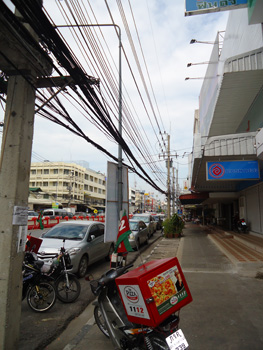 After a lengthy trip to Australia we had the opportunity of a few days in Thailand on the way home and the chance to see Spoonbill Sandpiper on its wintering grounds was just too good to miss. Originally we were booked to stay at The Courtyard by Marriott in Bangkok but with the flooding situation in the area continuing to deteriorate whilst we travelled around Australia, we contacted our Travel Agents in the UK and switched our destination to the Hyatt Regency Hotel, Hua Hin, c230kms south of Bangkok.
After a lengthy trip to Australia we had the opportunity of a few days in Thailand on the way home and the chance to see Spoonbill Sandpiper on its wintering grounds was just too good to miss. Originally we were booked to stay at The Courtyard by Marriott in Bangkok but with the flooding situation in the area continuing to deteriorate whilst we travelled around Australia, we contacted our Travel Agents in the UK and switched our destination to the Hyatt Regency Hotel, Hua Hin, c230kms south of Bangkok.
RESEARCH and GUIDES

With such a brief stay there was little need to spend a lot of time trying to find the best places to visit. However if planning a longer trip numerous reports can be found online at Travelling Birder, Surfbirds, Birdtours and Fatbirder. However in reality you need go no further than Nick Upton’s website thaibirding.com which contains all the information a visiting birder is likely to need, including extensive site details.
The Field Guide we chose was Birds of Thailand (Princeton Field Guides), although if planning a longer trip I would probably also take A Field Guide to the Birds of South-East Asia by the same author Craig Robson. Thailand (Lonely Planet Country Guides) is also a useful addition to your hand luggage.
When planning our trip in March 2011 I emailed Peter Ericsson, Nick Upton and a Thai bird guide to see if they were available to guide us on 15th November and as I hadn’t heard from Nick when Peter replied on 30th March and the Thai guide had confirmed he was already booked, we decided to go with Peter. Nick confirmed he was available on 4th April, but by then the die was already cast. Peter’s fee for the day was 11,000 Baht (£225) to include transport from Bangkok, lunch, entrance fees, boat trip etc. Rather belatedly on 2nd September, with our departure less than 6 weeks away, we received an email from Peter advising us that he had agreed to guide another party of two for 5 days, also beginning on 15th November:-
“I am in a dilemma. Your day on the 15th is logged in.
I have another 5 day trip that begins the 15th as well. 2 people. They do the same sites as you do. What are my options?
1. Use my passenger van for all 4 of you and hire a taxi for you to get back to Bangkok.
2. Find someone else to do the 1st day with the other people.
3. Find a driver for a second vehicle, bird together and have him bring you back.
4. I could of course tell you I can’t do the trip but I don’t like being true to my words so that is not an option.
Any ideas?”
Yes we had ideas, but only a few of them were polite; Peter’s problem really should not have been ours! Agreeing to a much longer trip for two people, which started on the day we had specifically booked, appeared to be purely financially motivated on Peter’s part. As we would have been travelling around Australia for over a month just prior to our one day’s birding in Thailand, we had no desire to share this day with other birders. We didn’t want to be working to someone else’s agenda as our targets for the day were quite specific; hence the reason we had booked our guide so far in advance. Initially we reluctantly agreed to join the party, provided certain logistics could be sorted out to our satisfaction and feeling we had little alternative. Surprisingly, no reduction in fee was offered!

At the same time we replied to Peter, I decided to email Nick Upton to see if he was still available and, quite fortuitously, he was. His fee was also 11,000 Baht for the same package. We immediately booked a day with Nick and cancelled Peter, saying we would probably see him on the day as, birding the same area, our paths were bound to cross……and they did, several times. With hindsight we were very lucky to end up spending our time birding with Nick; he knows his birds and the area very well, is excellent company and has a wry take on the politics and life in general in the country which has been his adopted home for the last 15 years. On the assumption we will return, we will make sure Nick is available when we do.
DIARY and SITES VISITED
Sunday 13th November
Our flight left Sydney at 17.35 and we arrived in Bangkok at 22.45 local time and following a painless transfer to our private transport we travelled c230kms and reached the Hyatt Regency Hotel in Hua Hin at c02.00. After what seemed like a lengthy checking-in process we were shown to our room and sleep was the only thing on our minds.
Monday 14th November
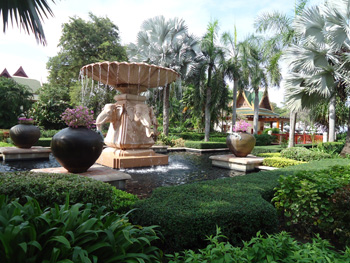 Surprisingly we were awake at 07.10 without an alarm call. We had an excellent breakfast in the hotel and then went for a look around Hua Hin, which we found interesting but uninspiring. We returned to hotel around lunch time and with an early start tomorrow, decided to spend the afternoon relaxing around the extensive hotel grounds. With binoculars always close at hand we did manage to see a few birds, including Zebra Dove, Asian Palm Swift, Barn Swallow (Ssp.gutturalis), Tree Sparrow, c8 Streak-eared Bulbul, 2 White-vented Myna, Black Drongo and Common Tailorbird. We added a further 6 species to our trip list, 3 of which were lifers – OK for a non-birding day! Temperatures were c30°C and of course, it was quite humid. We had dinner in the hotel, having decided on an early night.
Surprisingly we were awake at 07.10 without an alarm call. We had an excellent breakfast in the hotel and then went for a look around Hua Hin, which we found interesting but uninspiring. We returned to hotel around lunch time and with an early start tomorrow, decided to spend the afternoon relaxing around the extensive hotel grounds. With binoculars always close at hand we did manage to see a few birds, including Zebra Dove, Asian Palm Swift, Barn Swallow (Ssp.gutturalis), Tree Sparrow, c8 Streak-eared Bulbul, 2 White-vented Myna, Black Drongo and Common Tailorbird. We added a further 6 species to our trip list, 3 of which were lifers – OK for a non-birding day! Temperatures were c30°C and of course, it was quite humid. We had dinner in the hotel, having decided on an early night.
Tuesday 15th November
Whilst in Australia, bearing in mind the flooding in and around Bangkok, we had kept in touch with Nick Upton who was to guide us today around the Pak Thale and Laem Pak Bia areas. We went down to the hotel reception desk at 06.00 to collect the picnic breakfast we had arranged on our arrival and Nick was waiting for us as expected. We quickly threw our gear in his car and set off north towards Petchaburi and then east towards the coast and the Gulf of Thailand. Wanting to get to our destination as early as possible before the birds were disturbed by the locals, we didn’t stop along the way until we were well in to the salt pans which are characteristic of this area. With Nick “on a mission” and the scenery flying by, the only bird I managed to ID was a Jungle (Large-billed) Crow flying up from the road as we approached it. Our first stop was a small roadside wetland on the left/north side of the main road, which held hundreds of egrets and other waterbirds, including c60 Painted Stork (including a leucistic bird), 2 Milky Stork, Marsh Sandpiper, Whiskered Tern, Brown-headed Gull and Chinese Pond Heron (or was it Indian?….this was the one species Nick refused to be drawn on as “out of breeding plumage” these pond herons are virtually indistinguishable). We could see flocks of waders flying around over the salt pans opposite so we drove on towards Pak Thale and just before the town we turned right, off the main road and on to a track which led in to the salt pans. To start off with the track was reasonably wide and there are several spots suitable for parking or turning round. There are literally thousands of waders around these pans with Black-tailed Godwit, Eurasian Curlew, Lesser (Tibetan) Sand Plover and Great Knot being most common and in numbers so big it wasn’t worth counting. Black-winged Stilt and Marsh Sandpiper are also quite common, but in much smaller numbers and in total, we had 29 species of wader in the area. We saw two cars and a few other birders stopped towards the end of the track and, hoping they had done all the hard work for us, we stopped alongside. Amongst the more common species we found Spotted Redshank, Little Ringed Plover Wood Sandpiper and Red-necked Stint, whilst hirundines above were mainly Germain’s Swiftlet and Barn Swallow, together with the occasional Asian Palm Swift. A photographer advised us “the sandpiper” had been there earlier, but had flown off some time ago. Undaunted, and having seen a vey distant bird off to our left just after we arrived, Nick took us for a walk a little further in to the salt pans, towards where the bird had been. We took care navigating our way around a small wooden shack which almost took up the whole of the path and on the other side, began scanning the masses of waders again. In no time at all I managed to find a bird that looked different and sure enough we soon had a Spoon-billed Sandpiper in the scopes: as if that wasn’t good enough there was a second bird a few yards away and we were able to watch both until we had had our fill. With hindsight I am really glad they were just too far away for a photo as, with my lens continuing to play up following an accident with the camera in Cairns, I have ditched the greater majority of shots taken that day. I would have been absolutely gutted to get good close-ups of the bird only to find they were blurred and out of focus on the big screen.
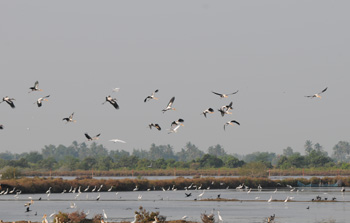 Moving on, around the salt pans we also had c10 Bar-tailed Godwit, c40 Red Knot, c20 Curlew Sandpiper, 4 Sanderling, 2 Turnstone, a single Kentish Plover and at least 4 Broad-billed Sandpiper. We returned to the main road and headed away from Pak Thale, stopping briefly for another look at the storks and herons which were in quite a skittish mood and frequently took to the sky en masse – what a spectacle! A little further along the road, as we scanned the distant waders looking for greenshank, we found Grey Plover and several Red Collared (Turtle) Dove which had landed on the wires behind us along with 3 Common Kestrel; quite unusual here with single birds the norm. As we drove along we spotted the occasional Common Sandpiper by the roadside, with a few Little Tern darting overhead. Leaving the salt pans for a while we drove a short way north of the road where there were some flooded fields and drier areas. As we drove along a track towards one of the many Buddhist temples in the area we stopped for an Oriental Skylark singing overhead, a Common Greenshank and 2 Black-headed Ibis pottering about in the water meadows alongside c30 Eastern Cattle Egret. A Red-throated Pipit darted by, giving the briefest of views, whilst nearer the temple, Pied Myna (Starling) and Brown Shrike were much more confiding, as was a White-throated Kingfisher. Leaving the temple behind, we drove a little further north to get around the back of the fields and look at the more open water there. From the road we saw Asian Openbill, Red-wattled Lapwing, Little Grebe and the first of several migrating Eastern Stonechat (Stejnegeri’s Stonechat), as a pair of Ashy Woodswallow perched on the wires above our heads. Taking another track around the back of the fields, c6 Streak-eared Bulbul flitted about in the bushes whilst Richard’s Pipit and Pheasant-tailed Jacana moved about in the wet grassland. The duck we had seen on the water, in the distance from the temple track, proved to be c40 Garganey and whilst watching them we also picked up c6 Grey-headed Lapwing, c30 Pacific Golden Plover and up to 6 Paddyfield Pipit.
Moving on, around the salt pans we also had c10 Bar-tailed Godwit, c40 Red Knot, c20 Curlew Sandpiper, 4 Sanderling, 2 Turnstone, a single Kentish Plover and at least 4 Broad-billed Sandpiper. We returned to the main road and headed away from Pak Thale, stopping briefly for another look at the storks and herons which were in quite a skittish mood and frequently took to the sky en masse – what a spectacle! A little further along the road, as we scanned the distant waders looking for greenshank, we found Grey Plover and several Red Collared (Turtle) Dove which had landed on the wires behind us along with 3 Common Kestrel; quite unusual here with single birds the norm. As we drove along we spotted the occasional Common Sandpiper by the roadside, with a few Little Tern darting overhead. Leaving the salt pans for a while we drove a short way north of the road where there were some flooded fields and drier areas. As we drove along a track towards one of the many Buddhist temples in the area we stopped for an Oriental Skylark singing overhead, a Common Greenshank and 2 Black-headed Ibis pottering about in the water meadows alongside c30 Eastern Cattle Egret. A Red-throated Pipit darted by, giving the briefest of views, whilst nearer the temple, Pied Myna (Starling) and Brown Shrike were much more confiding, as was a White-throated Kingfisher. Leaving the temple behind, we drove a little further north to get around the back of the fields and look at the more open water there. From the road we saw Asian Openbill, Red-wattled Lapwing, Little Grebe and the first of several migrating Eastern Stonechat (Stejnegeri’s Stonechat), as a pair of Ashy Woodswallow perched on the wires above our heads. Taking another track around the back of the fields, c6 Streak-eared Bulbul flitted about in the bushes whilst Richard’s Pipit and Pheasant-tailed Jacana moved about in the wet grassland. The duck we had seen on the water, in the distance from the temple track, proved to be c40 Garganey and whilst watching them we also picked up c6 Grey-headed Lapwing, c30 Pacific Golden Plover and up to 6 Paddyfield Pipit.
The area we were in is just a mass of fields (some waterlogged), salt pans and water-bodies, interspersed with temples and human habitation. The roads are all small and in the main, un-named, with many tracks leading off towards the horizon. It is therefore quite difficult to give perspective to our record, other than to say without Nick’s vast local knowledge we would never have visited a lot of the varied habitats he took us to, with everywhere looking almost identical to our foreign eyes. For further information visit Nick’s web site.
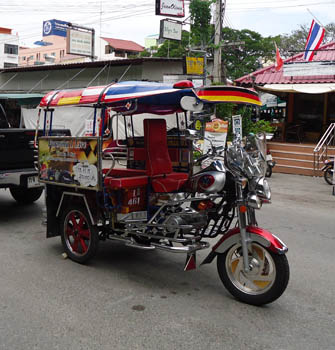 Anyway, moving on yet again, we returned to the main road and yet more salt pans. Nick spotted a huge flock of Great Knot, so with antennae raised, we got out of the car and scanned the vista. The white blobs in the flock turned out to be a mixture of Common and Little Tern and standing a short distance away from the main flock were 5 Nordmann’s Greenshank, another of our main target species. Nick and I decided to walk along the narrow bank of the nearest salt pan to get a better view of the birds, but Amanda decided discretion was the better part of valour and remained behind with the car. We must have walked c100 metres along the narrow bank with a shallow ditch at one side and the pan on the other, with Nick advising falling in was not an option, as the gloopy substance “stank to high heaven” and I would not be allowed back in his car if I did. We eventually got unbelievably close to the birds which remained calm and appeared oblivious to our approach, obviously well used to locals working the salt pans and being in close proximity. We set up our scopes, with both the tripod and our legs straddling the ditch precariously. But it was well worth the effort. We were able to examine the finer points of Nordmann’s Greenshank in depth and also spotted 3 Long-toed Stint, a single Eastern Yellow Wagtail and Richard’s Pipit on the banks of the pans.
Anyway, moving on yet again, we returned to the main road and yet more salt pans. Nick spotted a huge flock of Great Knot, so with antennae raised, we got out of the car and scanned the vista. The white blobs in the flock turned out to be a mixture of Common and Little Tern and standing a short distance away from the main flock were 5 Nordmann’s Greenshank, another of our main target species. Nick and I decided to walk along the narrow bank of the nearest salt pan to get a better view of the birds, but Amanda decided discretion was the better part of valour and remained behind with the car. We must have walked c100 metres along the narrow bank with a shallow ditch at one side and the pan on the other, with Nick advising falling in was not an option, as the gloopy substance “stank to high heaven” and I would not be allowed back in his car if I did. We eventually got unbelievably close to the birds which remained calm and appeared oblivious to our approach, obviously well used to locals working the salt pans and being in close proximity. We set up our scopes, with both the tripod and our legs straddling the ditch precariously. But it was well worth the effort. We were able to examine the finer points of Nordmann’s Greenshank in depth and also spotted 3 Long-toed Stint, a single Eastern Yellow Wagtail and Richard’s Pipit on the banks of the pans.
As we drove along in the direction of Laem Pak Bia we made several roadside stops for 2 Oriental (Collared) Kingfisher, a single Common Redshank, several Black-capped Kingfisher and c6 Temminck’s Stint, almost at arm’s length at the side of the road, as they fed at the edge of a pan with Wood Sandpiper and more Long-toed Stint. 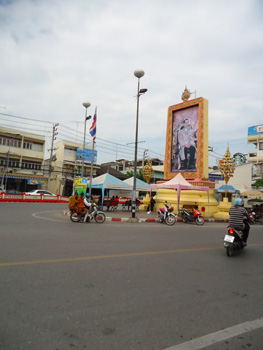 Nick then took us off the main road to another water-body, surrounded by fields and reeds, with a sizeable herd of grazing cattle. 4 Gull-billed Tern and a single Heuglin’s Gull drifted over the water along with an Eastern Marsh Harrier, whilst around us we picked up 4 Plain-backed Sparrow, c10 Green Bee-eater and a single Chestnut Munia as it moved amongst the reeds in front of us. We also heard Zitting Cisticola and Oriental Reed Warbler in the reeds but were unable to pick them up. A Purple Heron skulked around in the middle distance as a Pied Kingfisher appeared, hovered, moved on a bit, hovered again and went about its business looking for food. We moved on a little way to a drier area on the opposite side of the road near some dwellings: there was also a small, long pond here and some marshy ground alongside. As we walked in to the area across a partially fenced off field we were surprised to find a single male House Sparrow near some buildings and even more surprised when we disturbed a Yellow Bittern which had been at the water’s edge, hidden in the long grass. It flew a few metres in to deep cover and unfortunately didn’t show itself again…bugger! In the bushes by the water we spotted a Pied Fantail as we waited for the bittern to reappear and, walking along a small embankment between the water and the wet grassland, we disturbed c6 Greater Painted Snipe, including a few females.
Nick then took us off the main road to another water-body, surrounded by fields and reeds, with a sizeable herd of grazing cattle. 4 Gull-billed Tern and a single Heuglin’s Gull drifted over the water along with an Eastern Marsh Harrier, whilst around us we picked up 4 Plain-backed Sparrow, c10 Green Bee-eater and a single Chestnut Munia as it moved amongst the reeds in front of us. We also heard Zitting Cisticola and Oriental Reed Warbler in the reeds but were unable to pick them up. A Purple Heron skulked around in the middle distance as a Pied Kingfisher appeared, hovered, moved on a bit, hovered again and went about its business looking for food. We moved on a little way to a drier area on the opposite side of the road near some dwellings: there was also a small, long pond here and some marshy ground alongside. As we walked in to the area across a partially fenced off field we were surprised to find a single male House Sparrow near some buildings and even more surprised when we disturbed a Yellow Bittern which had been at the water’s edge, hidden in the long grass. It flew a few metres in to deep cover and unfortunately didn’t show itself again…bugger! In the bushes by the water we spotted a Pied Fantail as we waited for the bittern to reappear and, walking along a small embankment between the water and the wet grassland, we disturbed c6 Greater Painted Snipe, including a few females.
It was, by now, almost lunch time and with the sun beating down the temperature had risen above 30° C. We were following the coast road south towards Hat Chao Samran and our next stop was the Environmental Research and Development Project which had been set up by H M King Bhumibol.  This is an area of mangroves and settling pools and is currently being drained, to start all over again. We stopped at a guarded gatehouse, Nick got out of the car and paid a small fee; the barrier was raised and we drove around the pools, which unlike any other (of the many…) sewage works we have visited, were beautifully landscaped and topiarised, with the grass almost appearing manicured and lots of flowering shrubs. Although the heat was almost unbearable and there was no shade, we took a short walk and found Oriental Reed Warbler (at last), Racket-tailed Treepie, Asian Koel, Greater Coucal and a stunning male Olive-backed Sunbird. There were plenty of terns, gulls and waders on the ponds, but nothing new.
This is an area of mangroves and settling pools and is currently being drained, to start all over again. We stopped at a guarded gatehouse, Nick got out of the car and paid a small fee; the barrier was raised and we drove around the pools, which unlike any other (of the many…) sewage works we have visited, were beautifully landscaped and topiarised, with the grass almost appearing manicured and lots of flowering shrubs. Although the heat was almost unbearable and there was no shade, we took a short walk and found Oriental Reed Warbler (at last), Racket-tailed Treepie, Asian Koel, Greater Coucal and a stunning male Olive-backed Sunbird. There were plenty of terns, gulls and waders on the ponds, but nothing new.
We drove on to Laem Pak Bia for lunch in a small waterside “restaurant”, placing our trust in Nick entirely as no English was spoken. The restaurant was nothing more than a roadside shack which had no sides, with five or six rickety tables and pale blue plastic chairs which had definitely seen better days – apart from the seats they were mainly grey. The drinks and food were refrigerated but cooking was done in a wok on an open stove, by the roadside. Apart from the three of us there wasn’t another Caucasian in sight. Having had a bad experience with a Thai salad at a restaurant in the UK on the only other occasion I had tried Thai food I was not very happy as we sat there, sipping delicious ice cold drinks and waiting for lunch. 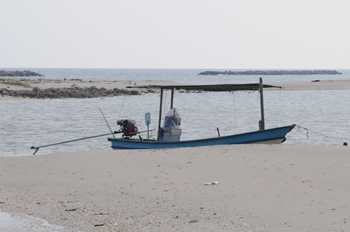 I needn’t have worried; the food was excellent and quite easily the best we had in our short visit to Thailand. The noodles, prawns and vegetables tasted wonderful and when we asked Nick what he had said to the cook it turned out he had just told her to “hold the chillies”.
I needn’t have worried; the food was excellent and quite easily the best we had in our short visit to Thailand. The noodles, prawns and vegetables tasted wonderful and when we asked Nick what he had said to the cook it turned out he had just told her to “hold the chillies”.
Lunch over; we drove a little further along the river near the spit at Laem Pak Bia for our boat ride with Mr Deng, a former fisherman who now takes birders out to the spit on a full time basis. Nick had booked the boat for 14.00 but we had to wait for 30 minutes until Mr Deng returned with his previous customer, guide Peter Ericsson and his two clients. The tide was very high and showed no sign of going out as we set off down the river: not a good sign as Chinese Egret, one of our targets, habitually roosted in the mangroves when the tide was full. Egrets flew from side to side across the river as we passed and after about 20 minutes we reached the spit and landed. At first there was only a small flighty flock of waders on the spit, but they slowly increased in number as we watched, with new birds joining all the time. We spent about an hour on the spit, seeing the occasional Caspian, Whiskered and c20 Little Tern, Brahminy Kite, Brown-headed and Heuglin’s Gull, together with 2 Pacific Reef Egret. 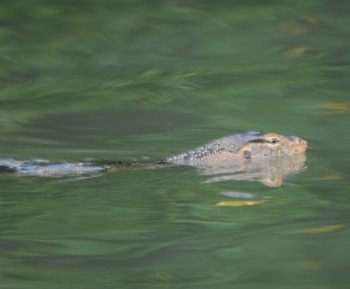 The wader flock which was mainly Malaysian Plover and Sanderling, with eventually c30/40 of each, initially also included a c4 Greater Sand Plover and c6 Kentish Plover. While we watched, as numbers increased, they were joined by c20 Red-necked Stint, c6 Curlew Sandpiper, c6 Grey Plover and eventually a single White-faced Plover. Returning to the boat dock we saw several Water Monitor swimming around in the river.
The wader flock which was mainly Malaysian Plover and Sanderling, with eventually c30/40 of each, initially also included a c4 Greater Sand Plover and c6 Kentish Plover. While we watched, as numbers increased, they were joined by c20 Red-necked Stint, c6 Curlew Sandpiper, c6 Grey Plover and eventually a single White-faced Plover. Returning to the boat dock we saw several Water Monitor swimming around in the river.
We then visited a couple of the sites we had been to earlier, to see if any new species had dropped in. A second Purple Heron had appeared, but there was nothing new on the water. However, by the roadside just behind us 2 Chestnut-tailed Starling sat on the wires and a Coppersmith Barbet flew in to a nearby tree. With very little else happening we decided to head back to our hotel after a veritable feast of waders and an excellent day’s birding with Nick. We had seen 94 species today, which included 19 lifers.
Wednesday 16th November
It was obviously going to be very hot again; after a long day in the field yesterday and with another long day ahead of us we decided to have a lazy day around the hotel. We had a leisurely breakfast, finished packing and went for a walk around the hotel grounds. As usual, Zebra Dove appeared around the swimming pools along with Common and White-rumped Myna. We were sitting by the pool having a coffee watching the world go by when the birds scattered and a Shikra flashed past and landed momentarily on a nearby tree. We vacated our room at lunch time, had a bite to eat and then settled down to relax in the shade. 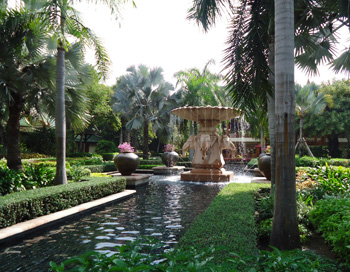 This isn’t really our scene and even though we were right at the end of a long holiday I was like a cat on hot bricks, jumping up every time a bird called. On one such occasion I stealthily stalked around the pool as a bird called and flitted amongst the upper branches of the surrounding trees. The bins were packed, but nevertheless I eventually managed to get a good view of the culprit – a male Oriental Magpie Robin. Our private taxi arrived at 17.00 for the trip to airport; with floods still threatening and only one main road open from the south to Bangkok, the return journey took a little over 4 hours. Leaving Hua Hin in the gathering gloom as the sun went down our final birds for the trip were Eastern Great & Little Egret, Germain’s Swiftlet and a single Asian Openbill. We made it to the airport c21.00 with plenty of time to check-in and relax in the lounge before our flight home at 00.10 on 17th Nov.
This isn’t really our scene and even though we were right at the end of a long holiday I was like a cat on hot bricks, jumping up every time a bird called. On one such occasion I stealthily stalked around the pool as a bird called and flitted amongst the upper branches of the surrounding trees. The bins were packed, but nevertheless I eventually managed to get a good view of the culprit – a male Oriental Magpie Robin. Our private taxi arrived at 17.00 for the trip to airport; with floods still threatening and only one main road open from the south to Bangkok, the return journey took a little over 4 hours. Leaving Hua Hin in the gathering gloom as the sun went down our final birds for the trip were Eastern Great & Little Egret, Germain’s Swiftlet and a single Asian Openbill. We made it to the airport c21.00 with plenty of time to check-in and relax in the lounge before our flight home at 00.10 on 17th Nov.
SUMMARY
During our brief stay in Thailand we saw 99 species, including 23 lifers, plus 1 heard (Zitting Cisticola) and these totals do not include the White-faced Plover sp. There is no doubt that without Nick Upton to guide us we would have only seen a small fraction of these species and having had an introduction to birding in Thailand, we plan to return there soon for a much longer stay.
